Geochronology/Paleozoic
< Geochronology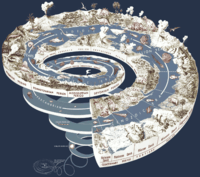
Geochronology/Paleozoic is the science of applying dates in the past to Paleozoic rocks. In many situations fossils and artifacts may yield dates applicable to the rocks they occur in.
Notations
Let
- ALMA represent the Asian Land Mammal Age,
- b2k represent before AD 2000,
- BP represent before present, as the chart is for 2008, this may require an added -8 for b2k,
- ELMMZ represent the European Land Mammal Mega Zone,
- FAD represent first appearance datum,
- FO represent first occurrence,
- Ga represent Gegaannum, billion years ago, or -109 b2k,
- GICC05 represent Greenland Ice Core Chronology 2005,
- GRIP represent Greenland Ice Core Project,
- GSSP represent Global Stratotype Section and Point,
- HO represent highest occurrence,
- ICS represent the International Commission on Stratigraphy,
- IUGS represent the International Union of Geological Sciences,
- LAD represent last appearance datum,
- LO represent lowest occurrence,
- Ma represent Megaannum, million years ago, or -106 b2k,
- NALMA represent the North American Land Mammal Age,
- NGRIP represent North Greenland Ice Core Project, and
- SALMA represent South American Land Mammal Age.
"The term b2 k [b2k] refers to the ice-core zero age of AD 2000; note that this is 50 years different from the zero yr for radiocarbon, which is AD 1950 [...]."[1]
Chronostratigraphy
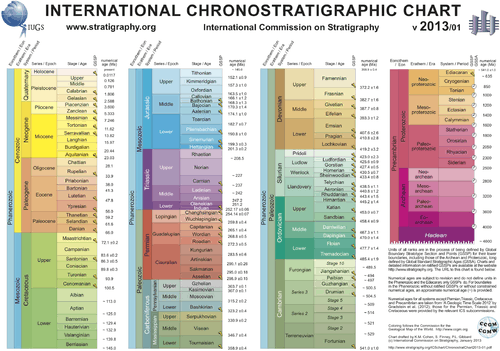
Dates have been assigned to specific geologic stratigraphy frames, columns, or columnar units.
Geochronologic time frames
| Name (English)[2] | base/start (Ma)[3] | top/end (Ma)[3] | status | subdivision of | usage | named after | author, year | |
|---|---|---|---|---|---|---|---|---|
| Abereiddian | 471.8 ± 1.6 | 464 | age | Ordovician | regional | Abereiddy (Wales) | ||
| Actonian | 454 | 453 | age | Ordovician | regional | Acton Scott (England) | ||
| Aeronian | 439.0 ± 1.8 | 436.0 ± 1.9 | age | Silurian | ICS | Cwm-coed-aeron (Wales) | Cocks et al., 1971 | |
| Aksayan | 493 | 491.5 | age | Cambrian | Russia, Kazakhstan | |||
| Albertan | epoch | Cambrian | North America | |||||
| Alportian | 324.5 | 318.1 ± 1.3 | age | Carboniferous | regional | Alport (England) | ||
| Amgan | 513.0 ± 2.0 | 502 | age | Cambrian | Russia, Kazakhstan | |||
| Arenig(-ian) | epoch | Ordovician | Europe | Arenig Fawr (Wales) | Sedgwick, 1847; Fearnsides 1905 | |||
| Arnsbergian | 326 | 325 | sub-age | Carboniferous | regional | |||
| Artinskian | 284.4 ± 0.7 | 275.6 ± 0.7 | age | Permian | ICS | Arti (Russia) | Karpinsky, 1874 | |
| Arundian | 341 | 339 | age | Carboniferous | regional | |||
| Asbian | 337.5 | 333 | age | Carboniferous | regional | |||
| Ashbyan | age | Ordovician | North America | |||||
| Ashgill(-ian) | epoch | Ordovician | Europe | Ashgill (Scotland) | ||||
| Asselian | 299.0 ± 0.8 | 294.6 ± 0.8 | age | Permian | ICS | river Assel (Kazakhstan) | Ruzhenchev, 1954 | |
| Asturian | 305 | age | Carboniferous | Europe | Asturias | |||
| Atdabanian | 530 | 524 | age | Cambrian | Russia, Kazakhstan | |||
| Atokan | age | Carboniferous | North America | |||||
| Aurelucian | 460.9 | 457 | age | Ordovician | Europe | |||
| Autunian | ~300 | ~275 | age | Carboniferous-Permian | Europe | Autun (France) | ||
| Ayusokkanian | 501.0 ± 2.0 | 494.5 | age | Cambrian | Russia, Kazakhstan | |||
| Baishaean | 433 | 429 | age | Silurian | China | |||
| Baotan | 460.9 | 454.5 | age | Ordovician | China | |||
| Barruelian | age | Carboniferous | Europe | |||||
| Bashkirian | 318.1 ± 1.3 | 311.7 ± 1.1 | age | Carboniferous | ICS | Bashkortostan | ||
| Batyrbayan | 491.5 | 488.3 | age | Cambrian | Russia, Kazakhstan | |||
| Bendigonian | 473.5 | 471.8 | age | Ordovician | Australia | Bendigo, Victoria | ||
| Black River(-an) | age | Ordovician | North America | |||||
| Bolindian | 450 | 443.7 | age | Ordovician | Australia | |||
| Bolsovian | age | Carboniferous | Europe | Bolsover (England) | ||||
| Boomerangian | 504 | 501 | age | Cambrian | Australia | |||
| Botomian | 524 | 518.5 | age | Cambrian | Russia, Kazakhstan | |||
| Brigantian | 336 | 326.4 ± 1.6 | age | Carboniferous | North America, Europe | Brigantes (Celtic tribe) | ||
| Burrellian | 457 | 455 | age | Ordovician | Europe | Glenburrell (England) | ||
| Caerfai | 542 ± 0.2 | 513 ± 2 | age | Cambrian | Europe (obsolete) | Caerfai Bay (Wales) | ||
| Cambrian | 542.0 ± 1.0 | 488.3 ± 1.7 | period | Paleozoic | ICS | Cambria (Latin for Wales) | Sedgwick, 1835 | |
| Canadian | epoch | Ordovician | North America | |||||
| Cantabrian | 305 | age | Carboniferous | Europe | ||||
| Capitanian | 265.8 ± 0.7 | 260.4 ± 0.7 | age | Permian | ICS | Capitan Reef (Texas, US) | ||
| Caradocian | 460.9 | 449.5 | epoch | Ordovician | Europe | Caradoc (Welsh king) | Murchison, 1839 | |
| Carboniferous | 359.2 ± 2.5 | 299.0 ± 0.8 | period | Paleozoic | ICS | carbon | Conybeare & Phillips, 1822 | |
| Cassinian | 473 | 471.8 | sub-age | Ordovician | North America | |||
| Castlemanian | 471 | 470 | age | Ordovician | Australia | Castlemaine | ||
| Cautleyan | 447.5 | 446.5 | age | Ordovician | Europe | Cautley Spout (England) | ||
| Cayugan | 421.3 ± 2.6 | 416.0 ± 2.8 | age | Silurian | North America | |||
| Cisuralian | 299.0 ± 0.8 | 270.6 ± 0.7 | epoch | Permian | ICS | |||
| Chadian | 345.3 ± 2.1 | 341 | age | Carboniferous | regional | |||
| Chamovnicheskian | 306 | 305 | age | Carboniferous | Russia | |||
| Champlanian | epoch | Ordovician | North America | |||||
| Changhsingian | 253.8 ±0.7 | 251.0 ± 0.4 | age | Permian | ICS | Changxing (China) | ||
| Changlangpuan | 523 | 518 | age | Cambrian | China | |||
| Changshanian | 496.8 | 492.5 | age | Cambrian | China | |||
| Chatauquan | 370 | 359.2 ± 2.5 | age | Devonian | South America | |||
| Chautauquan | age | Devonian | North America | |||||
| Chazyan | age | Ordovician | North America | |||||
| Cheneyan | 455 | 452 | age | Ordovician | Europe | |||
| Cheremshankian | 314.5 | 313.4 | age | Carboniferous | Russia | |||
| Chesterian | 333 | 318.1 | age | Carboniferous | North America | |||
| Chewtonian | 473 | 471 | age | Ordovician | Australia | |||
| Chokierian | 325 | 324.5 | sub-age | Carboniferous | regional | |||
| Cincinnatian | 451 | 443.7 ± 1.5 | epoch | Ordovician | North America | Cincinnati | ||
| Costonian | 460.9 | 459 | age | Ordovician | regional | |||
| Couvinian | 397.5 ± 2.7 | 391.8 ± 2.7 | age | Devonian | Belgium (obsolete) | Couvin | d'Omalius d'Halloy, 1862 | |
| Cressagian | 488.3 ± 1.7 | 486 | age | Ordovician | Europe | |||
| Croixan | epoch | Cambrian | North America | |||||
| Dalanian (Dalaun) | 313 | 310 | age | Carboniferous | China | |||
| Dapingian | 471.8 ± 1.6 | 468.1 ± 1.6 | age | Ordovician | ICS | Daping (China) | ||
| Darriwilian | 468.1 ± 1.6 | 460.9 ± 1.6 | age | Ordovician | ICS | Darriwil (Australia) | Hall, 1899 | |
| Datangian | 345 | 333 | age | Carboniferous | China | |||
| Datsonian | 488.3 ± 1.7 | 485 | age | Ordovician | Australia | |||
| Dawanian | 472 | 471.8 | age | Ordovician | North America | |||
| Deerparkian | age | Devonian | North America | |||||
| Delamaran | 512 | 504 | age | Cambrian | North America | |||
| Demingian | 478.6 | 475 | sub-age | Ordovician | North America | |||
| Derryan | 311.7 ± 1.1 | 308 | age | Carboniferous | North America | |||
| Desmoinesian | age | Carboniferous | North America | |||||
| Devonian | 416.0 ± 2.8 | 359.2 ± 2.5 | period | Paleozoic | ICS | Devon (England) | Murchison & Sedgwick, 1839 | |
| Dewuan | 333 | 318.1 ± 1.3 | age | Carboniferous | China | |||
| Dinantian | 359.2 ± 2.5 | 326.4 ± 1.6 | epoch/sub-period | Carboniferous | Northern Europe | Dinant | ||
| Dittonian | 418 | age | Devonian | Wales and England (obsolete) | Ditton Priors, Shropshire, England | |||
| Dolgellian | 492.5 | 488.3 ± 1.7 | age | Cambrian | regional | Dolgellau, Wales | ||
| Dorogomilovksian | 305 | 303.9 ± 0.9 | age | Carboniferous | regional | |||
| Dresbachian | 501 | 496.8 | age | Cambrian | North America | |||
| Drumian | 506.5 | 503 | age | Cambrian | ICS | Drum Mountains (Utah, US) | ||
| Duckmantian | age | Carboniferous | Europe | Duckmanton Railway Cutting, England | ||||
| Dyeran | 524.5 | 512 | age | Cambrian | North America | |||
| Eastonian | 456 | 450 | age | Ordovician | Australia | |||
| Edenian | age | Ordovician | North America | |||||
| Eifelian | 397.5 ± 2.7 | 391.8 ± 2.7 | age | Devonian | ICS | the Eifel (Germany) | Beyrich, 1837 | |
| Eildonian | 433 | 428.2 ± 2.3 | age | Silurian | Australia | |||
| Elvirian | 326 | 324.5 | age | Carboniferous | regional | |||
| Emsian | 407.0 ± 2.8 | 397.5 ± 2.7 | age | Devonian | ICS | Bad Ems (Germany) | de Dorlodot, 1900 | |
| Erian | 391.8 ± 2.7 | 388 | age | Devonian | North America | |||
| Famennian | 374.5 ± 2.6 | 359.2 ± 2.5 | age | Devonian | ICS | the Famenne (Belgium) | Dumont, 1855 | |
| Fengshanian | 492.5 | 488.3 ± 1.7 | age | Cambrian | China | |||
| Fennian | 473 | 471.8 | age | Ordovician | Europe | |||
| Festiniogian | 496.8 | 492.5 | age | Cambrian | regional | |||
| Floian | 478.6 ± 1.7 | 471.8 ± 1.6 | age | Ordovician | ICS | Flo (Sweden) | ||
| Florian | 508 | 504 | age | Cambrian | Australia | |||
| Fortunian | 542.0 ± 1.0 | 528 | age | Cambrian | ICS | Fortune Head (Canada) | ||
| Franconian | 496.8 | 492.5 | age | Cambrian | North America | |||
| Frasnian | 385.3 ± 2.6 | 374.5 ± 2.6 | age | Devonian | ICS | Frasne (Belgium) | d'Omalius d'Halloy, 1862 | |
| Furongian | 501.0 ± 2.0 | 488.3 ± 1.7 | epoch | Cambrian | ICS | Furong (China) | ||
| Gedinian | 416.0 ± 2.8 | 411.2 ± 2.8 | age | Devonian | Belgium (obsolete) | Gedinne | Dumont, 1848 | |
| Gisbornian | 460.9 | 456 | age | Ordovician | Australia | |||
| Givetian | 391.8 ± 2.7 | 385.3 ± 2.6 | age | Devonian | ICS | Givet (France) | d'Omalius d'Halloy, 1839 | |
| Gleedonian | 425.4 | 422.9 ± 2.5 | age | Silurian | regional | |||
| Gorstian | 422.9 ± 2.5 | 421.3 ± 2.6 | age | Silurian | ICS | Gorsty (farm at Ludlow, England) | Holland et al., 1980 | |
| Guadalupian | 270.6 ± 0.7 | 260.4 ± 0.7 | epoch | Permian | ICS | Guadalupe Mountains (Texas, US) | ||
| Guandian | 425.5 | 422 | age | Silurian | China | |||
| Gushanian | 596.8 | 501 | age | Cambrian | China | |||
| Guzhangian | 503 | 499 | age | Cambrian | ICS | Guzhang (China) | ||
| Gzhelian | 303.9 ± 0.9 | 299.0 ± 0.8 | age | Carboniferous | ICS | Gzhel (Russia) | ||
| Harnagian | 459 | 458 | age | Ordovician | regional | |||
| Hastarian | 359.2 ± 2.5 | 348 | age | Carboniferous | regional | |||
| Hirnantian | 445.6 ± 1.5 | 443.7 ± 1.5 | age | Ordovician | ICS | Cwm Hirnant (Wales) | Bancroft, 1933 | |
| Holkerian | 339 | 337.5 | age | Carboniferous | regional | |||
| Homerian | 426.2 ± 2.4 | 422.9 ± 2.5 | age | Silurian | ICS | Homer (England) | Bassett et al., 1975 | |
| Honghuayuanian | 478.6 | 472 | age | Ordovician | China | |||
| Houldjinian | 37.2 | 33.9 | ALMA | Asia | ||||
| Huashibanian | 318.1 ± 1.3 | 313 | age | Carboniferous | China | |||
| Ibexian | ~505 | 471.8 | age | Cambrian-Ordovician | North America | |||
| Idamean | 497 | 494 | age | Cambrian | Australia | |||
| Ivorean | 348 | 345.3 ± 2.1 | age | Carboniferous | regional | |||
| Jiusian | age | Carboniferous | China | |||||
| Jeffersonian | 475 | 473 | sub-age | Ordovician | North America | |||
| Karoo Ice Age | ~360 | ~260 | ice age | Phanerozoic | Karoo (South Africa) | |||
| Kashirskian | 309.2 | 308.0 | age | Carboniferous | Russia | |||
| Kasimovian | 306.5 ± 1.0 | 303.9 ± 0.9 | age | Carboniferous | ICS | Kasimov (Russia) | ||
| Katian | 455.8 ± 1.6 | 445.6 ± 1.5 | age | Ordovician | ICS | Lake Katy (Oklahoma, US) | ||
| Kazanian | age | Permian | Russia | |||||
| Keiloran | 443.7 ± 1.5 | 433 | age | Silurian | Australia | |||
| Kekeamuan | 28.4 | 33.9 | ALMA | Asia | ||||
| Kinderhookian | 359.2 ± 2.5 | 348 | age | Carboniferous | North America | |||
| Kinderscoutian | 318.1 ± 1.3 | 317 | age | Carboniferous | regional | Kinder Scout (England) | ||
| Kirkfield | 458 | 457 | age | Ordovician | regional | |||
| Klazminskian | 303.9 ± 0.9 | 300.5 | age | Carboniferous | regional | |||
| Krevyakinskian | 306.5 | 306 | age | Carboniferous | Russia | |||
| Kungurian | 275.6 ± 0.7 | 270.6 ± 0.7 | age | Permian | ICS | Kungur (Russia) | ||
| Lancefieldian | 482 | 475 | age | Ordovician | Australia | |||
| Langsettian | 314.5 | 313.4 | age | Carboniferous | regional | Langsett (England) | ||
| Leonardian | age | Permian | North America | |||||
| Linxiangian | 454.5 | 449 | age | Ordovician | China | |||
| Livian | 335 | 331 | age | Carboniferous | Belgium (obsolete) | Lives | ||
| Llandeilo (Llandeilean) | epoch/age | Ordovician | Europe | Llandeilo (Wales) | Murchison, 1835 | |||
| Llandovery | 443.7 ± 1.5 | 428.2 ± 2.3 | epoch | Silurian | ICS | Llandovery (Wales) | Murchison, 1859 | |
| Llanvirn(-ian) | epoch | Ordovician | Europe | Hicks, 1875 | ||||
| Lochkovian | 416.0 ± 2.8 | 411.2 ± 2.8 | age | Devonian | ICS | Lochkov (Czech Republic) | ||
| Longmaxian | 443.7 ± 1.5 | 438 | age | Silurian | China | |||
| Longvillian | 457 | 455 | age | Ordovician | regional | Cheney Longville (England) | ||
| Longwangmioan | 518 | 513 | age | Cambrian | China | |||
| Lopingian | 260.4 ± 0.7 | 251.0 ± 0.4 | epoch | Permian | ICS | Loping (China) | ||
| Ludfordian | 421.3 ± 2.6 | 418.7 ± 2.7 | age | Silurian | ICS | Ludford (England) | Holland et al., 1980 | |
| Ludlovian | 422.9 ± 2.5 | 418.7 ± 2.7 | epoch | Silurian | ICS | Ludlow (England) | Murchison, 1854 | |
| Luosuan | 318.1 | ~314 | age | Carboniferous | China | |||
| Maentwrogian | 501 | 496.8 | age | Cambrian | regional | Maentwrog (Wales) | ||
| Maozhangian | 513 | 509 | age | Cambrian | China | |||
| Mapingian | 310 | 299.0 ± 0.8 | age | Carboniferous | China | |||
| Marjuman | 504 | 494.5 | age | Cambrian | North America | |||
| Marsdenian | 317 | 315.5 | age | Carboniferous | regional | Marsden, West Yorkshire, England | ||
| Marshbrookian | 455 | 454 | age | Ordovician | regional | Marshbrook (England) | ||
| Mayan | 502 | 501 ± 2.0 | age | Cambrian | Russia, Kazakhstan | |||
| Mayvillian | 453 | 447.5 | age | Ordovician | North America | |||
| Medinan | age | Silurian | North America | |||||
| Meishuchuan | 542 | 532 | age | Cambrian | China | |||
| Melbournian | 428.2 ± 2.3 | 416.0 ± 2.8 | age | Silurian | Australia | Melbourne | ||
| Melekesskian | 313.4 | 311.7 | age | Carboniferous | Russia | |||
| Meramecian | 340 | 333 | age | Carboniferous | North America | |||
| Merioneth | 501 ± 2 | 488.3 ± 1.7 | epoch | Cambrian | Europe (obsolete) | Merioneth (Wales) | ||
| Miaogoalingian | 422 | 418.7 | age | Silurian | China | |||
| Migneintian | 486 | 478.6 ± 1.7 | age | Ordovician | Europe | |||
| Mindyallan | 501 | 497 | age | Cambrian | Australia | |||
| Mississippian | 359.2 ± 2.5 | 318.1 ± 1.3 | epoch | Carboniferous | ICS | Mississippi River (US) | ||
| Missourian | age | Carboniferous | North America | |||||
| Mohawkian | 462 | 451 | epoch | Ordovician | North America | |||
| Montezuman | 529.5 | 524.5 | age | Cambrian | North America | |||
| Moridunian | 478.6 ± 1.7 | 475 | age | Ordovician | Europe | Moridunum (Wales) | ||
| Morrowan | age | Carboniferous | North America | |||||
| Moscovian | 311.7 ± 1.1 | 306.5 ± 1.0 | age | Carboniferous | ICS | Moscow (Russia) | ||
| Myachkovskian | 307.2 | 306.5 | age | Carboniferous | Russia | |||
| Namurian | 326.4 | 313.0 | age | Carboniferous | Europe | Namur (Belgium) | Purves, 1883 | |
| Nemakit-Daldynian | 542 | 534 | age | Cambrian | Russia, Kazakhstan | |||
| Neocomian | 145.5 | 125.0/130.0 | epoch | obsolete | Neocomium, Latin name for Neuchâtel | |||
| Niagaran | age | Silurian | North America | |||||
| Noginskian | 300.5 | 299.0 ± 0.8 | age | Carboniferous | Russia | |||
| Ochoan | age | Permian | North America | |||||
| Okaian | 0.5 | 0.3 | sub-age | Ordovician | North America | |||
| Onnian | 453 | 449 | age | Ordovician | regional | River Onny (England) | ||
| Ordian | 520 | 510 | age | Cambrian | Australia | |||
| Ordovician | 488.3 ± 1.7 | 443.7 ± 1.5 | period | Paleozoic | ICS | Ordovices, Celtic tribe | Lapworth, 1879 | |
| Osagean | age | Carboniferous | North America | |||||
| Paibian | 501.0 ± 2.0 | 496 | age | Cambrian | ICS | Paibi (China) | ||
| Paleophytic | ~450 | ~270 | era | paleobotany | old flora | |||
| Paleozoic | 542.0 ± 1.0 | 251.0 ± 0.7 | era | Phanerozoic | ICS | old life | ||
| Payntonian | 491 | 488.3 ± 1.7 | age | Cambrian | Australia | |||
| Pendleian | 326.4 ± 1.6 | 326 | age | Carboniferous | regional | Pendle Hill (England) | ||
| Pennsylvanian | 318.1 ± 1.3 | 299.0 ± 0.8 | epoch | Carboniferous | ICS | Pennsylvania (US) | ||
| Permian | 299.0 ± 0.8 | 251.0 ± 0.4 | period | Paleozoic | ICS | Perm (Russia) | Murchison, 1849 | |
| Phanerozoic | 542.0 ± 1.0 | present | eon | ICS | visible life | |||
| Podolskian | 308 | 307.2 | age | Carboniferous | Russia | |||
| Potsdamian | 501 ± 2 | 488.3 ± 1.7 | epoch | Cambrian | Germany | |||
| Poundian | 570 | 542 ± 0.3 | age | Cambrian | Australia | |||
| Pragian | 411.2 ± 2.8 | 407.0 ± 2.8 | age | Devonian | ICS | Prague (Czech Republic) | ||
| Pridoli(an) | 418.7 ± 2.7 | 416.0 ± 2.8 | epoch | Silurian | ICS | Přidoli (Czech Republic) | ||
| Pusgillian | 449 | 447.5 | age | Ordovician | Europe | Pus Gill, Cumbria (England) | Dean, 1959 | |
| Qungzusian | 532 | 523 | age | Cambrian | China | |||
| Rawtheyan | 446.5 | 445.5 | age | Ordovician | Europe | River Rawthey (England) | ||
| Rhuddanian | 443.7 ± 1.5 | 439.0 ± 1.8 | age | Silurian | ICS | Cwm-Rhuddian (Wales) | ||
| Richmondian | 449 | 445.6 ± 1.5 | age | Ordovician | North America | |||
| Roadian | 270.6 ± 0.7 | 268.0 ± 0.7 | age | Permian | ICS | |||
| Rotliegend(-es)[4] | 299 | 270.6 | sub-period | Permian | unofficial | German for "Red foot wall". | A traditional copper mining term in the Mansfelder Land for the red oreless sandstone below the Kupferschiefer. | |
| Sakian | 494.5 | 493 | age | Cambrian | Russia, Kazakhstan | |||
| Sakmarian | 294.6 ± 0.8 | 284.4 ± 0.7 | age | Permian | ICS | river Sakmara (Russia) | Karpinski, 1874 | |
| Sandbian | 460.9 ± 1.6 | 455.8 ± 1.6 | age | Ordovician | ICS | Sandby, Sweden | ||
| Saxonian | ~290 | ~258 | age | Permian | Europe (obsolete) | Saxony | ||
| Senecan | 388 | 370 | age | Devonian | North America | |||
| Serpukhovian | 326.4 ± 1.6 | 318.1 ± 1.3 | age | Carboniferous | ICS | Serpukhov (Russia) | ||
| Shangsian | 318.1 | age | Carboniferous | China | ||||
| Shaodongian | 359.2 ± 2.5 | 349.5 | age | Carboniferous | China | |||
| Sheinwoodian | 428.2 ± 2.3 | 426.2 ± 2.4 | age | Silurian | ICS | Sheinwood (England) | Basset et al., 1975 | |
| Shermanian | 457 | 454 | age | Ordovician | regional | |||
| Shinulanian | 438 | 433 | age | Silurian | China | |||
| Silesian | 326.4 | 299.0 | subperiod | Carboniferous | Europe | Silesia | ||
| Siegenian | age | Devonian | North America, Europe | |||||
| Silurian | 443.7 ± 1.5 | 416.0 ± 2.8 | period | Paleozoic | ICS | Silures, Celtic tribe | Murchison, 1835 | |
| Soudleyan | 458 | 457 | age | Ordovician | regional | Soudley (England) | ||
| Springerian | age | Carboniferous | North America | |||||
| St. David's | 513 ± 2 | 501 ± 2 | epoch | Cambrian | Europe (obsolete) | St Davids (Wales) | ||
| Stephanian | 303.9 | 299.0 | age | Carboniferous | Europe | Saint-Étienne (France) | Mayer-Eymar, 1878 | |
| Steptoan | 494.5 | 493 | age | Cambrian | North America | |||
| Streffordian | 452 | 449 | age | Ordovician | Europe | Strefford (England) | ||
| Sunwaptan | 493 | 491 | age | Cambrian | North America | |||
| Tangbagouan | 359.2 | age | Carboniferous | China | ||||
| Tatarian | age | Permian | Russia | Tatarstan | ||||
| Telychian | 436.0 ± 1.9 | 428.2 ± 2.3 | age | Silurian | ICS | Pen-lan-Telych (Wales) | Cocks et al. 1973 | |
| Templetonian | 510 | 508 | age | Cambrian | Australia | |||
| Terreneuvian | 542.0 ± 1.0 | 521 | epoch | Cambrian | ICS | Terre-Neuve, French name for Newfoundland | ||
| Thuringian | 285 | 251 | age | Permian | Europe (obsolete) | Thuringia (Germany) | ||
| Toyonian | 518.5 | 513.0 ± 2.0 | age | Cambrian | Russia, Kazakhstan | |||
| Tommotian | 534 | 530 | age | Cambrian | Russia, Kazakhstan | |||
| Tournaisian | 359.2 ± 2.5 | 345.3 ± 2.1 | age | Carboniferous | ICS | Tournai (Belgium) | Dumont, 1832 | |
| Tremadoc(-ian) | 488.3 ± 1.7 | 478.6 ± 1.7 | epoch | Ordovician | ICS | Tremadoc Bay (Wales) | Sedgwick, 1846 | |
| Trempealeauan | 492.5 | 488.3 ± 1.7 | age | Cambrian | North America | |||
| Trentonian | age | Carboniferous | North America | |||||
| Ufimian | 268 | 270,6 | age | Permian | obsolete | |||
| Ulsterian | age | Devonian | North America | |||||
| Undillian | 506 | 504 | age | Cambrian | Australia | |||
| Vereiskian | 311.7 ± 1.1 | 309.2 | age | Carboniferous | Russia | |||
| Virgilian | age | Carboniferous | North America | |||||
| Visean | 345.3 ± 2.1 | 326.4 ± 1.6 | age | Carboniferous | ICS | Visé (Belgium) | Dumont, 1832 | |
| Warendian | 485 | 478.6 | age | Ordovician | Australia | |||
| Waucoban | epoch | Cambrian | North America | |||||
| Wenlock(-ian) | 428.2 ± 2.3 | 422.9 ± 2.5 | epoch | Silurian | ICS | Much Wenlock (England) | Murchison, 1833 | |
| Westphalian | 313.0 | 303.9 | age | Carboniferous | Europe | Westphalia (Germany) | de Lapparent & Munier-Chalmas, 1892 | |
| Whiterockian | 471.8 ± 1.6 | 462 | age | Ordovician | North America | |||
| Whitlandian | 475 | 473.5 | age | Ordovician | Europe | Whitland (Wales) | ||
| Whitwellian | 426.2 ± 2.4 | 425.4 | age | Silurian | regional | Whitwell Coppice (England) | ||
| Wolfcampian | age | Permian | North America | |||||
| Wordian | 268.0 ± 0.7 | 265.8 ± 0.7 | age | Permian | ICS | |||
| Wuchiapingian | 260.4 ± 0.7 | 253.8 ± 0.7 | age | Permian | ICS | |||
| Xiaodushanian | 299 | age | Carboniferous | China | ||||
| Xiushanian | 429 | 425.5 | age | Silurian | China | |||
| Yanguan | 349.5 | 345 | age | Carboniferous | China | |||
| Yeadonian | 315.5 | 314.5 | age | Carboniferous | regional | Yeadon (England) | ||
| Ypeenian | 470 | 468.1 | age | Ordovician | Australia | |||
| Zechstein[4] | ±270 | ±250 | sub-period | Permian | Europe (unofficial) | |||
| Zhungxian | 505 | 501 | age | Cambrian | China | |||
| Zuzhungian | 509 | 503 | age | Cambrian | China |
Permian
The Permian lasted from 299.0 ± 0.8 to 251.0 ± 0.4 Mb2k.
Carboniferous
The Carboniferous began 359.2 ± 2.5 Mb2k and ended 299.0 ± 0.8 Mb2k.
Pennsylvanian
The Pennsylvanian lasted from 318.1 ± 1.3 to 299.0 ± 0.8 Mb2k.
Mississippian
The Mississippian lasted from 359.2 ± 2.5 to 318.1 ± 1.3 Mb2k.
Middle Mississippian
"This species has been consistently identified with the considerably younger, late Viséan (late Holkerian to Asbian [late Meramecian to early Chesterian]) genus Beyrichoceras Foord, 1903 (type species, Goniatites obtusus Phillips, 1836) (eg, Gordon, 1965, p. 284."[5]
Visean

"The first appearance of Eoparastaffella simplex in the lineage Eoparastaffela ovalis - Eoparastaffella simplex (foraminifers) [is] the new biostratigraphic criterion to define the base of the Viséan."[6]
Tournaisian
"The base of the Carboniferous System, Mississippian Sub-System and Tournaisian Stage is defined at the base of Bed 89 in Trench E' at La Serre, France. It coincides with the first appearance of the conodont Siphonodella sulcata within the evolutionary lineage from Siphonodella praesulcata to Siphonodella sulcata."[7]
Devonian
The Devonian spanned 416.0 ± 2.8 to 359.2 ± 2.5 Mb2k.
Famennian

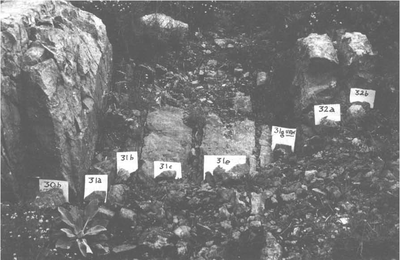
"The boundary for the Frasnian/Famennian Stage Global Stratotype Section and Point (GSSP) [...] is drawn [above] in a section exposed [in the second image above] near the Upper Coumiac Quarry in the southeastern Montagne Noire, France."[8]
Silurian
The Silurian spanned 443.7 ± 1.5 to 416.0 ± 2.8 Mb2k.
Telychian
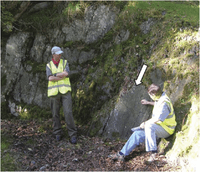
On the right is an image of the type locality for the Telychian base GSSP indicated by an arrow which points parallel to the bedding. Older bedding of the Aeronian is to the right. The Telychian GSSP is in the Wormwood Formation, Cefn Cerig quarry.
In the section below for the Aeronian, the lower Telychian is marked with a Ⓣ.
Aeronian
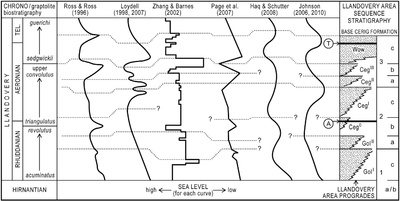
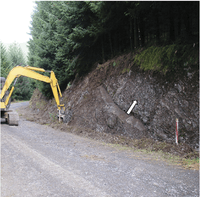
The diagram above has the GSSP for the base of the Aeronian symbolized by a Ⓐ. The upper GSSP for the end of the Aeronian is symbolized by a Ⓣ.
On the right is the type locality for the base of the Aeronian indicated by the arrow. Actual beds are perpendicular to the arrow. The base of the Aeronian is in the Cefngarreg Sandstone Formation (formerly Trefawr Formation), Trefawr track section, Crychan Forest, Central Wales.
Ordovician
The Ordovician lasted from 488.3 ± 1.7 to 443.7 ± 1.5 Mb2k.
Actonian

The "Onny Valley [...] is the type locality for the Actonian and Onnian substages, and a [Site of Special Scientific Interest] SSSI."[9]
On the right is a geological map of the Onny Valley section together with a strategraphic column, sample localities and the chrono- and lithostratigraphy of the southern Caradoc area (after Rushton et al. 2000).
Sandbian
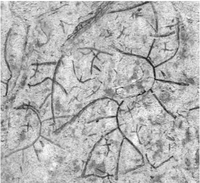
"The Lower Sandbian Nemagraptus gracilis Zone comprises one of the most widespread, and easily recognizable graptolite faunas in the Ordovician System. The base of the N. gracilis Zone also marks the base of the Upper Ordovician Series, and is internationally defined by the FAD of the eponymous species, with the Global Stratotype Section and Point (GSSP) located at Fågelsång in Scania, southern Sweden (Bergström et al., 2000, 2009)."[10]
Abereiddian
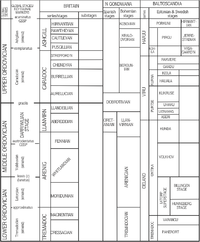
On the right is an Ordovician chart which illustrates the stratigraphic relationships between the Global Series, Stages and key faunal markers, and the main regional series, stage and substage divisions used in different parts of the world (after Webby 1988).
Here, the Abereiddian is the lower portion of the Llanvirn series, which in turn is the upper portion of Darriwilian Stage, of the upper Middle Ordovician.
Cambrian
The Cambrian lasted from 542.0 ± 1.0 to 488.3 ± 1.7 Mb2k.
Furongian
The Furongian Series includes Cambrian Stage 10, Cambrian Stage 9, and the Paibian Stage.[11]
Stage 10
The FAD of Lotagnosthus americanus is the primary stratigraphic tool for correlation of the base for Stage 10.[11]
Stage 9
The FAD of Agnostotes orientalis is the primary stratigraphic tool for correlation of the base for Stage 10.[11]
Paibian
The "FAD of Glyptagnostus reticulatus [is the primary stratigraphic tool for correlation of the base] for the Paibian Stage."[11]
Guzhangian
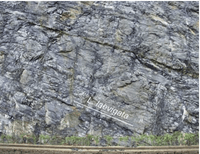

"The Global boundary Stratotype Section and Point (GSSP) for the base of the Guzhangian Stage (Cambrian Series 3) is defined at the base of a limestone (calcisiltite) layer 121.3 m above the base of the Huaqiao Formation in the Louyixi section along the Youshui River (Fengtan Reservoir), about 4 km northwest of Luoyixi (4 km southeast of Wangcun), in northwestern Hunan, China."[11]
"The GSSP level contains the lowest occurrence of the cosmopolitan agnostoid trilobite Lejopyge laevigata [in the image on the left] (base of the L. laevigata Zone)."[11]
Drumian
The "FAD of Ptychagnostus atavus [is the primary stratigraphic tool for correlation of the base (GSSP)] for the Drumian Stage".[11]
Stage 3
The FAD of trilobites is the primary stratigraphic tool for correlation of the base for Stage 3.[11]
Terreneuvian
The Terreneuvian Series includes Cambrian Stage 2 and the Fortunian Stage.[11]
Fortunian
The FAD of Trichophycus pedum is the primary stratigraphic tool for correlation of the base (GSSP) for the Fortunian Stage.[11]
Precambrian
Def.
- "the time and geology dated before the Phanerozoic"[12] or
- the "eon (or supereon) and rock formations dated before 541.0±1.0 million years ago, coinciding with the first appearance of the fossils of hard-shelled animals"[12]
is called the precambrian.
Usage notes[12]
- The International Commission on Stratigraphy, which attempts to standardize the vocabulary of the field, is revising the boundaries between time periods based on physical-science methods rather than the kinds of fossils present.
- The boundary between the Precambrian and the Phanerozoic has been changed from time to time and will be subject to change.
Research
Hypothesis:
- Each time frame or span of time in geochronology has at least one dating technique.
- Late Ordovician and Upper Ordovician are different time frames.
Control groups

The findings demonstrate a statistically systematic change from the status quo or the control group.
“In the design of experiments, treatments [or special properties or characteristics] are applied to [or observed in] experimental units in the treatment group(s).[13] In comparative experiments, members of the complementary group, the control group, receive either no treatment or a standard treatment.[14]"[15]
Proof of concept
Def. a “short and/or incomplete realization of a certain method or idea to demonstrate its feasibility"[16] is called a proof of concept.
Def. evidence that demonstrates that a concept is possible is called proof of concept.
The proof-of-concept structure consists of
- background,
- procedures,
- findings, and
- interpretation.[17]
See also
References
- ↑ Mike Walker, Sigfus Johnsen, Sune Olander Rasmussen, Trevor Popp, Jørgen-Peder Steffensen, Phil Gibbard, Wim Hoek, John Lowe, John Andrews, Svante Björck, Les C. Cwynar, Konrad Hughen, Peter Kershaw, Bernd Kromer, Thomas Litt, David J. Lowe, Takeshi Nakagawa, Rewi Newnham and Jakob Schwander (2009). "Formal definition and dating of the GSSP (Global Stratotype Section and Point) for the base of the Holocene using the Greenland NGRIP ice core, and selected auxiliary records". Journal of Quaternary Science 24 (1): 3-17. doi:10.1002/jqs.1227. http://www.stratigraphy.org/GSSP/Holocene.pdf. Retrieved 2015-01-18.
- ↑ Names from local versions of the geologic timescale can often be found in the local language. The English name is usually found by replacing the suffix in the local language for -an or -ian. Examples for "local" suffices are -en (French), -ano (Spanish), -ium (German), -aidd (Welsh) or -aan (Flemish Dutch). The English name "Norian", for example, becomes Noriano in Spanish, Norium in German, Noraidd in Welsh or Norien in French.
- 1 2 Time is given in Megaannum (million years BP, unless other units are given in the table. BP stands for "years before present". For ICS-units the absolute ages are taken from Gradstein et al. (2004).
- 1 2 This name is often still used in a chronostratigraphic or geochronologic sense, although it is now officially a lithostratigraphic unit.
- ↑ David M. Work and Charles E. Mason (November 2004). "Mississippian (Late Osagean) Ammonoids from the New Providence Shale Member of the Borden Formation, North-Central Kentucky". Journal of Paleontology 78 (6): 1128-37. doi:10.1666/0022-3360(2004)078<1128:MLOAFT>2.0.CO;2). http://www.psjournals.org/doi/abs/10.1666/0022-3360%282004%29078%3C1128%3AMLOAFT%3E2.0.CO%3B2. Retrieved 2015-01-30.
- ↑ François-Xavier Devuyst, Luc Hance, Hongfei Hou, Xianghe Wu, Shugang Tian, Michel Coen, and George Sevastopulo (June 2003). "A proposed Global Stratotype Section and Point for the base of the Viséan Stage (Carboniferous): the Pengchong section, Guangxi, South China". Episodes 26 (2): 105. http://www.stratigraphy.org/GSSP/Tournaisian.pdf. Retrieved 2015-01-29.
- ↑ S. I. Kaiser (2009). "GSSP for Tournaisian Stage". Stratigraphy.org. Retrieved 2015-01-29.
- ↑ G Klapper, R Feist, R T Becker and M R House (December 1993). "Definition of the Frasnian/Famennian Stage Boundary". Episodes 16 (4): 433-41. http://www.stratigraphy.org/GSSP/Famennian.pdf. Retrieved 2015-01-27.
- ↑ Thijs R. A. Vandenbroucke, Antonio Ancilletta, Richard A. Fortey and Jacques Verniers (2009). "A modern assessment of Ordovician chitinozoans from the Shelve and Caradoc areas, Shropshire, and their significance for correlation". Geology Magazine 146 (2): 216-36. doi:10.1017/S0016756808005815. https://biblio.ugent.be/input/download?func=downloadFile&recordOId=532329&fileOId=532330. Retrieved 2015-01-15.
- ↑ J.C. Gutiérrez-Marco, D. Goldman, J. Reyes-Abril, and J. Gómez (2011). J.C. Gutiérrez-Marco, I. Rábano and D. García-Bellido. ed. A Preliminary Study of Some Sandbian (Upper Ordovician) Graptolites from Venezuela, In: Ordovician of the World. Madrid: Instituto Geológico y Minero de España. pp. 199-206. ISBN 978-84-7840-857-3. http://digital.csic.es/bitstream/10261/60947/1/ORDOVICIAN%20OF%20THE%20WORLD_199_206.pdf. Retrieved 2015-01-15.
- 1 2 3 4 5 6 7 8 9 10 Shanchi Peng, Loren E. Babcock, Jingxun Zuo, Huanling Lin, Xuejian Zhu, Xianfeng Yang, Richard A. Robison, Yuping Qi, Gabriella Bagnoli, and Yong’an Chen (March 2009). "The Global Boundary Stratotype Section and Point (GSSP) of the Guzhangian Stage (Cambrian) in the Wuling Mountains, Northwestern Hunan, China". Episodes 32 (1): 41-55. http://www.stratigraphy.org/GSSP/Guzhangian.pdf. Retrieved 2015-01-21.
- 1 2 3 "Precambrian, In: Wiktionary". San Francisco, California: Wikimedia Foundation, Inc. 4 November 2014. Retrieved 2015-02-12.
- ↑ Klaus Hinkelmann, Oscar Kempthorne (2008). Design and Analysis of Experiments, Volume I: Introduction to Experimental Design (2nd ed.). Wiley. ISBN 978-0-471-72756-9. http://books.google.com/?id=T3wWj2kVYZgC&printsec=frontcover.
- ↑ R. A. Bailey (2008). Design of comparative experiments. Cambridge University Press. ISBN 978-0-521-68357-9. http://www.cambridge.org/uk/catalogue/catalogue.asp?isbn=9780521683579.
- ↑ "Treatment and control groups, In: Wikipedia". San Francisco, California: Wikimedia Foundation, Inc. May 18, 2012. Retrieved 2012-05-31.
- ↑ "proof of concept, In: Wiktionary". San Francisco, California: Wikimedia Foundation, Inc. November 10, 2012. Retrieved 2013-01-13.
- ↑ Ginger Lehrman and Ian B Hogue, Sarah Palmer, Cheryl Jennings, Celsa A Spina, Ann Wiegand, Alan L Landay, Robert W Coombs, Douglas D Richman, John W Mellors, John M Coffin, Ronald J Bosch, David M Margolis (August 13, 2005). "Depletion of latent HIV-1 infection in vivo: a proof-of-concept study". Lancet 366 (9485): 549-55. doi:10.1016/S0140-6736(05)67098-5. http://www.ncbi.nlm.nih.gov/pmc/articles/PMC1894952/. Retrieved 2012-05-09.
External links
| |||||||||||||||||||||||||||||||||||
![]() This is a research project at http://en.wikiversity.org
This is a research project at http://en.wikiversity.org
| |
Development status: this resource is experimental in nature. |
| |
Resource type: this resource is an article. |
| |
Resource type: this resource contains a lecture or lecture notes. |
| |
Subject classification: this is a Geology resource. |